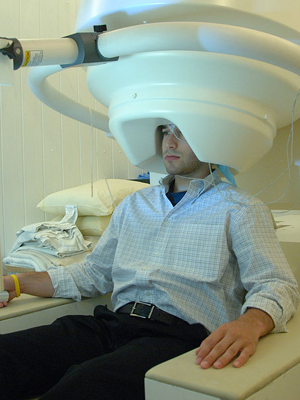MEG Data Driven Music

Fig. 1 - Typical MEG experiment
Magnetoencephalography (MEG) is a method of studying neural activity by measuring the small magnetic field changes in and around a subject's brain (Fig. 1). These measurements can be done using a few different methods, however, the MEG machine that I used as an undergraduate utilized an array of superconducting quantum interference devices (SQUIDs) to serve as a sensitive magnetometer able to measure fields as low as 5e-18T! For a comparison, the Earth's magnetic field strength is a relatively whopping 5e-6T!
The electro-chemical activity of the brain can be inferred by MEG measurements because of the orthogonality of magnetic fields and electric fields. In other words, subtle electrical changes in the brain can be inferred directly by their associated magnetic fields (Fig. 2). This is particularly useful because magnetic fields are prone to less distortion from the skull which allows for a cleaner signal.

Fig. 2 - E and B fields are orthogonal
While a member of the Sinha Lab, I studied the high level correlates of familiar face perception. This project resulted in a manuscript that was never published leaving a nice dataset just prime for creative expression to take hold of it! Originally I had played around with the idea of using the physiological "head plots" as some sort of visual art piece but then decided to turn some of the neural recordings into music instead. This change in plans was due to an inspiring poster session which explored the intersection of neuroscience and music.
All audio samples were first ripped from the synthesizer software packaged with an OLPC prototype and pitch shifted in Matlab to give me an "instrument" to control using the neural data. Then data was segregated by hemisphere so that audio generated from one side of the brain would then be processed by that same side. The bass drone represents data from individual experimental trials - slowly droning in and out as neural activity fluctuates. The treble represents moments where statistically significant changes occur within face sensitive parts of the brain. Pitch shifting was done to attempt less chaotic and more "in key" sound. It is important to note that although the audio is over the course of a few minutes, the data that it represents is occurring at a much smaller timescale. The face selective responses reflected are happening on the scale of ~170ms. A sample of the trippy MEG music is below.
Code is not available at the moment but will be posted when recovered.